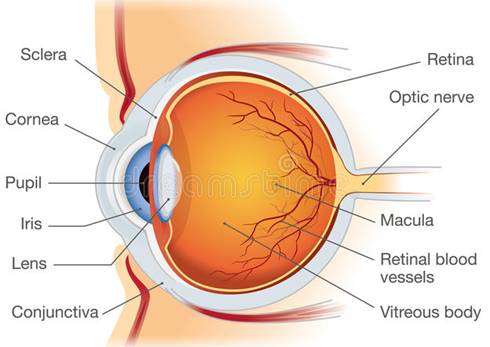Explain the structure and function of a human eye. How are we able to see nearby as well as distant objects?
Eye consists of following parts:
Cornea: The front surface of the eye is covered by a transparent spherical membrane called the cornea. Light enters the eye through the cornea. It acts as a window that controls and focuses the entry of light into the eye. It also acts as a protective layer to the eye.
The space behind the cornea is filled with a liquid called aqueous humour.
Iris: The iris is a thin, circular structure in the eye, responsible for controlling the diameter and size of the pupil and thus the amount of light reaching the retina. Eye color is defined by that of the iris.
Pupil: Pupil is the small circular opening of iris. The pupil appears black because no light is reflected from it.
Eye lens: The eye lens is a convex lens made of a transparent jelly-like protein. The eye lens is held in position by ciliary muscles. The ciliary muscles help in changing the curvature and focal length of the eye lens.
Retina: The inner back surface of the eye ball is called retina. It is a semi-transparent membrane which is light sensitive. The light sensitive receptors of the retina are called rods and cones. When light falls on these receptors they send electrical signals to the brain through the optic nerve. The space between the retina and eye lens is filled with another fluid called vitreous humour
Blind spot: It is a spot at which the optic nerve enters the eye and is insensitive to light.
The light coming from an object enters the eye through cornea and pupil. Amount of light entering the eye depends on pupil and cornea. The eye lens converge these light rays to form a real, inverted and diminished image on the retina.
The light sensitive cells of the retina get activated with the incidence of light and generate electric signals.
These electric signals are sent to the brain by the optic nerves and the brain interprets the electrical signals in such a way that we see an image which is erect and of the same size as the object.

•When a person is trying to see far away objects, the ciliary muscles relaxes itself so that the lens elongates. This elongation of lens increased the focal length of the eye lens & thus we are able to see objects placed very far.
•The ciliary muscles contract itself if a person has to see nearby objects. This makes the lens more curved which causes the focal length to shorten itself so the person can see nearby objects.
•This is the reason why we are unable to see objects kept in room for a short time when we enter the room from outside. It takes a short time to accommodate the lens of eyes.